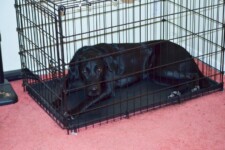How to Crate Train a Dog Who Hates the Crate (Good Tips)
Are you having trouble crate training your dog who hates the crate? Don’t worry, many dog owners struggle with this issue, but with the right approach, you can make the process much easier.
The short version to crate train a dog who hates the crate is: choose the right crate, gradually introduce your dog to it, use positive reinforcement, and be consistent with your approach. With patience and persistence, you’ll be able to help your dog learn to love their crate and make it a positive experience.
Crate training is an important part of dog ownership that can have many benefits for both you and your furry friend. However, if your dog hates their crate, it can be difficult to know what to do.
In this article, I’ll provide tips and tricks for crate training a dog who is resistant to the idea.
Understanding Your Dog’s Attitude Towards Crates
The first step in crate training a dog who hates their crate is to understand why they may be resistant. Some common reasons why dogs may be afraid of crates include:
- Negative past experiences
- Lack of exposure to crates at a young age
- Traumatic events while in the crate
- Fear of confinement
Creating a Positive Association with the Crate
Once you understand why your dog may be resistant to their crate, the next step is to create a positive association with the crate. This can be done by:
- Using treats and positive reinforcement. Offer your dog treats and praise when they are near the crate, and when they go into the crate, reward them with an even bigger treat and lots of praise.
- Making the crate a comfortable and inviting place. Add a soft blanket, bed, or cushion to the crate, and make sure the crate is in a quiet, comfortable place where your dog feels safe.
- Introducing the crate gradually. Start by placing treats and toys near the crate, and gradually move them closer to the crate, until your dog is comfortable going inside.
- Allowing your dog to explore the crate on their own terms. Let your dog sniff around the crate, and don’t force them to go inside. Just let them explore it on their own, and when they are ready, they will go inside on their own.
Training Techniques to Make the Crate a Happy Place
To help your dog become comfortable with their crate, it’s important to use the right training techniques. Some tips for successful crate training include:
- Gradually increasing the amount of time your dog spends in the crate. Start with just a few minutes at a time, and gradually increase the amount of time your dog spends in the crate, until they are comfortable staying in there for longer periods of time.
- Making sure the crate is the right size for your dog. The crate should be big enough for your dog to stand up, turn around, and lie down comfortably, but not so big that they have room to use one end of the crate as a bathroom and the other as a sleeping area.
- Providing your dog with plenty of toys and treats in the crate. This will help make the crate a fun and exciting place, and will encourage your dog to want to spend time in there.
- Training your dog to go into the crate on command. Use a positive command like “crate” or “kennel” to encourage your dog to go inside the crate, and reward them with treats and praise when they do.
Getting Your Dog Used to the Crate
Once you’ve created a positive association with the crate and have begun using effective training techniques, it’s time to start getting your dog used to the crate. This can be done by:
- Placing your dog’s bed, toys, and treats in the crate. This will help your dog associate the crate with positive things, like sleeping and playing.
- Feeding your dog their meals in the crate. This will encourage your dog to spend time in the crate, and will help them see it as a positive place.
- Gradually increasing the amount of time your dog spends in the crate. Start with just a few minutes at a time, and gradually increase the amount of time your dog spends in the crate, until they are comfortable staying in there for longer periods of time.
- Making sure the crate is always a happy and safe place for your dog. Keep the crate clean, and make sure it is always a place where your dog feels safe and secure.
The Bottom Line
Crate training a dog who hates their crate can be a challenge, but with patience and persistence, it’s possible.
By understanding your dog’s attitude towards crates, creating a positive association with the crate, using effective training techniques, and getting your dog used to the crate, you can help your furry friend become comfortable and happy in their crate.
By following these tips and being patient with your dog, you can help them learn to love their crate and enjoy spending time in it. Remember, consistency is key, so stick to a schedule and be patient as your dog adjusts.



